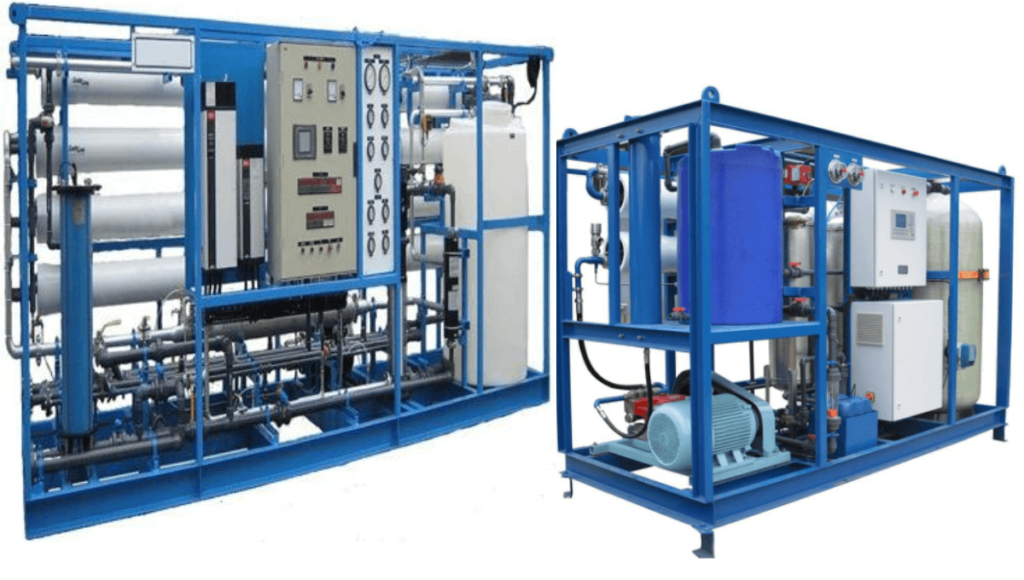A sea water reverse osmosis (SWRO) is the process of filtering salt water to produce drinking water and salt. This is a chemical-free process, which uses pressure and natural fluids to filter the salt from seawater.
The sea water reverse osmosis (SWRO) system works by pushing seawater under high pressure through a semi-permeable membrane with little resistance to only let small molecules or ions (like sodium, chloride, sulfate, and freshwater) in; forcing larger solids like salt out into a discharge tank. Salt water can be used for irrigation or algae production; aquaculture; fish hatcheries; seafood farms and coastal resorts. Let’s take a look at what the sea water reverse osmosis (SWRO) system entails and how it works!
What is the Sea Water Reverse Osmosis System?
A seawater reverse osmosis (SWRO) system is a desalination plant that uses pressure to separate fresh water from seawater. As its name suggests, this method works in the opposite way to the usual process for removing salt from seawater. In the traditional process, called “seawater distillation,” seawater is boiled to create steam, the steam is then cooled and turned back into liquid freshwater.
How Does a Sea Water Reverse Osmosis System Work?
The sea water reverse osmosis process uses a semi-permeable membrane to separate fresh water from seawater. As seawater flows through the membrane, freshwater flows through the membrane, and the seawater is left behind. This membrane is designed to allow larger salt particles to pass through while blocking smaller freshwater molecules. The pressure applied by the seawater increases the amount of freshwater that passes through the membrane. As more fresh water is produced, the pressure is reduced and the seawater flow is increased to maintain consistency. The membrane removes around 98% of the solids from the seawater, including bacteria, viruses, and algae. The water that is left after this process is then treated to remove any excess minerals so that it is drinkable.
Key Components of an SWRO System
A sea water reverse osmosis system consists of three main components – a seawater intake, an energy recovery device, and an evaporator. The seawater intake pumps seawater from the ocean into the system, which increases the pressure and pushes the water through the system. The energy recovery device uses excess heat from the process to power the system. The evaporator then turns the seawater into freshwater. The evaporator is the most important part of a seawater reverse osmosis system. During the process, it removes the salt from the water but leaves behind minerals that are essential for human health.
Pros of an SWRO System
Coastal residences and resorts can use seawater for irrigation. With minimal setup, seawater can irrigate gardens and lawns. – Using seawater for irrigation can save on water costs as well as reduce the need for fertilizer. – Seawater can also be used as a source of freshwater for fish hatcheries. As fish grow to maturity, they produce waste that can be harmful to other species of fish. – The SWRO can help reduce harmful bacteria and algae that can build up in freshwater areas. – The SWRO system is a chemical-free filtration method, which is environmentally friendly. The system produces little waste and requires little maintenance. – The cost of an SWRO system is usually less than other filtration methods, such as desalination.
Cons of an SWRO System
The SWRO system is an energy-intensive process that requires a lot of energy to run. – The system produces brine, a highly concentrated salt solution, which can be harmful to aquatic life if not disposed of properly. – If the system is not properly maintained, it can cause damage to the marine environment. – The seawater intake can damage the marine environment if it pulls in too much seawater. – The system requires regular maintenance to ensure it is running smoothly and safely.
Conclusion
The sea water reverse osmosis process uses a semi-permeable membrane to separate fresh water from seawater. The membrane is designed to allow larger salt particles to pass through while blocking smaller freshwater molecules. The pressure applied by the seawater increases the amount of freshwater that passes through the membrane. The system produces little waste and requires little maintenance, making it an environmentally friendly choice.
